Homemade Yellow Curry Powder
Posted on 12 April 2010
Curry was mentioned in the first English cook book commissioned by King Richard II in the 1300’s. I do not know if it is because I am English and it was ingrained in me by nationality, but I absolutely love curry. In fact I like people more if they also love curry (no offense non-curry eaters!). The fact that I still have not found a regular curry house in New York amazes me. I have had so many recommendations from friends recently though, so I will be trying a couple of them soon and report back.
Making curries at home has kept me going in between visits home to London. I had always just bought the regular curry powder in the plastic container from the grocery store assuming that was the best way to make curry at home. I would keep this bottle of curry powder until it ran out, using a teaspoon here, a tablespoon there, never thinking about just how long it would sit in my cupboard. It was not I recently, when I had several recipes containing curry powder, that I began to think about making my own.
While looking for a recipe for an all-purpose curry powder I learnt there is not just one recipe. There are so many ingredients that can be added to curry powder that I began to get overwhelmed. Some of the common spices I have seen included are tumeric (bright yellow, it gives curry powder its yellow color, for more information see below in notes), coriander seeds, cumin seeds, brown mustard seeds, yellow mustard seeds, chili powder, dried chilies, fenugreek seeds, cloves, ground ginger, garlic powder, onion powder, cinnamon, green cardomom, mace, nutmeg, poppyseeds, fennel seeds and black, white and red peppercorns!
As I have recently become obsessed with taste tests, which you would know if you saw my pimento cheese recipes from Friday, I decided that I would try out 2 different basic recipes. As I pointed out before, there are dozens of ingredients which could go into a curry powder with each recipe being as individual as the person creating it. I thought that these two curry powders would be a good starting place. They both contain a few of the more common ingredients: whole coriander seeds, whole cumin seeds, tumeric, whole fenugreek seeds and cloves. However, I also wanted to see how certain ingredients would affect the taste so there are a couple of differences; in one recipe I used yellow mustard seeds, the other brown mustard seeds; in one I used black peppercorns and in the other white peppercorns; and finally in one I used whole dried chilies (dried chile de arbol) and in the other ground red chili pepper (ground New Mexico chili); I also added whole fennel seeds to one of them and not to the other.
So the first starter recipe was tumeric and coriander based, also containing cumin seeds, ground fenugreek, ground yellow mustard, cloves, white peppercorns, ground red pepper and I added whole fennel seeds at the last minute to see how they would taste.
The second contained coriander, cumin, tumeric, cloves, fenugreek and also brown mustard seeds, black peppercorns and whole dried chilies.
Both recipes required toasting of the ingredients (however I made one batch without toasting and it has so much less depth of flavor). Toasting the seeds also changes the composition of the oil contained within the seeds resulting in a different flavor.
So the results… I completely subjectively preferred the second recipe. I think the fact that the chilies were just ground gives the spice a freshness that the pre-ground chili does not have. I also prefer the addition of the black peppercorns rather than the white as I believe it has a less muted flavor. As I said earlier though, this is just a starter recipe and you can tweak it, omit things, and add things in. The options with making your own curry powder are endless!
The winning curry powder.
Notes: I did not have whole fenugreek seeds or whole yellow mustard seeds at home and no grocery stores close to us did, so I used the ground variety of each. This means that not only would I be unable to get the full impact of the whole spice (the oils contained within each spice are very volatile and dissipate quickly when released from their seed), but also I was not able to toast them to develop the flavor. I would recommend trying to get the whole seeds for as many of the spices as possible, but both of my powders turned out tasting great. So while it is ideal to have the whole spice it is not compulsory.
You can store your homemade curry powder for as long as you would usually keep spices. Over time the pungency of the flavor will fade so it is best to use it soon after you make it.
On a side note, but an extremely important one nonetheless, the ingredients in curry powder are very beneficial to your health. I did not want to make this post all about nutrition and well being, but I also felt not adding these points here I feel would be negligent. Curcumin, a compound naturally found in tumeric, has long been used to treat inflammatory ailments in Asia but now it is being looked at as a potential new treatment for life threatening illnesses. Curcumin has been selected for further testing as it has been found to be a powerful anti-carcinogen. It has been linked to stabilizing patients of certain types of cancer, including pancreatic, colon, prostate and breast cancers. Research trials are underway at MD Anderson in Texas, to determine if curcumin is able to slow the growth of tumors and prevent the creation of new cancer cells. There are also prelimarinary tests at the neurology department of UCLA using curcumin to treat Alzheimer’s disease, as it is thought to prevent the build up of plaque on the neurons. They hope to soon begin testing on humans and are looking for people to enroll in their trial. Let’s hope this spice is able to provide some kind of cure to both these diseases.
Homemade Yellow Curry Powder, makes 5 to 6 tablespoons.
2 tbsp whole coriander seeds
1 tbsp whole cumin seeds
2 tsp whole black peppercorns
1 1/2 tsp whole brown mustard seeds
1 1/2 tsp ground tumeric
1 tsp whole fenugreek seeds (I used 1 tsp of ground fenugreek)
3 hot dried red chilies, crumbled (I used dried chile de arbol)
3 whole cloves
1. Heat a small frying pan over medium heat. When it gets hot, add coriander, cumin, peppercorns, mustard seeds, cloves and chilies. Keep moving the pan constantly, to make sure the spices do not burn, the spices will begin to begin to get toasted and become fragrant. Keep moving the pan over the heat until they begin to darken slightly in color. Add tumeric and fenugreek and stir constantly for 10-15 seconds.
2. Remove from heat and pour into a bowl. Allow to cool. Once cool, place into a spice grinder and grind until fine. Store in an air tight container.
10 responses to Homemade Yellow Curry Powder
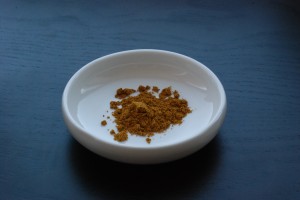
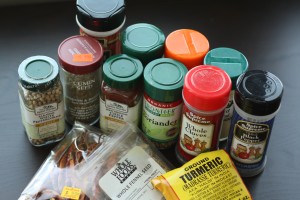
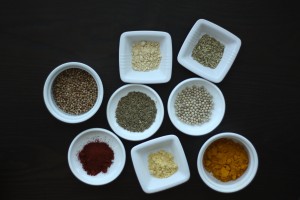
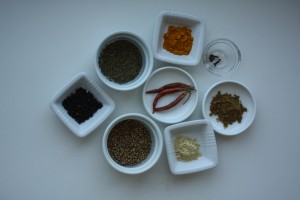
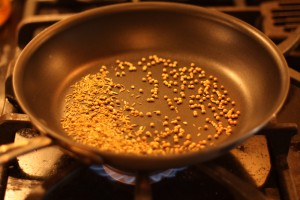
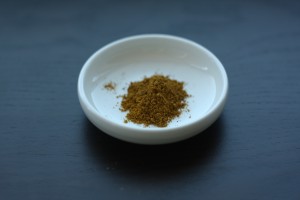

I just began making my own curry powders after my son-in law mentioned a Thai friend introducing him to red curry powder & how much he liked it. I filled spice jars for my gals group Christmas gifts – quite a hit! A couple of the gals were surprised that curry is a blend not an individual spice!
I just made another batch for myself & was out of yellow curry, so mad a batch very similar to yours from a foodnetwork recipe.- they also recommended toasting the spices, which I’ll try next time for the red as well!
Hi Nadya, freshly made curry powder packs so much more of a punch than the grocery store bought varieties and I try to use it up as quickly as I make it to make sure it always pungent. I picked parts and pieces from a few recipes before coming up with the two I eventually tested out.
Toasting the spices is a great way to heat the essential oils in the spices and bring out even more flavor! Thank you for reading and for commenting, Vienna*
[…] in another large pot, saute garlic in olive oil very quickly. Add about a teaspoon yellow curry powder. This gives it a warm flavor it needs. Then, handful by handful, add the chopped spinach and […]
[…] tablespoons yellow curry powder- I love this recipe for homemade but you can use […]
Several human intervention trials demonstrated that the antidiabetic effects of fenugreek seeds ameliorate most metabolic symptoms associated with type-1 and type-2 diabetes in both humans and relevant animal models by reducing serum glucose and improving glucose tolerance.’
My favorite blog
<.http://www.foodsupplementcenter.com/carnosine-side-effects/
Can I suggest the addition of grated (preferably whole)nutmeg and a touch of paprika, plus some cut up kaffir lime leaves. When making a yellow curry with chicken breasts last Sunday,
I found a recipe which called for the addition of some tbsps of fish stock. I also used coconut milk. The result was very tasty and much enjoyed.
[…] Adapted from tinytestkitchen.com […]
[…] the finishing touches that transformed it into a work of art. In the second recipe, the homemade yellow curry powder is the most lethal dynamite I could have ever concocted. Firepower has never intrigued me as […]
That is why furniture stores in Los Angeles are so popular.
It is an easy surface to decontaminate, washing with just water soap and water is all that is required, meaning cleaning
is simple in hygienic environments (orite.
Do business with the furniture supplier that will offer you with warranties for all products and
more importantly deal with the company that is more than willing to help
you in doing some preventive maintenance.
[…] http://www.tinytestkitchen.com/2010/04/homemade-yellow-curry-powder/ […]